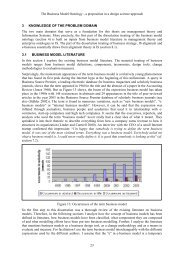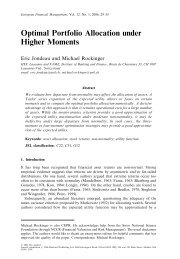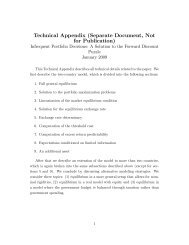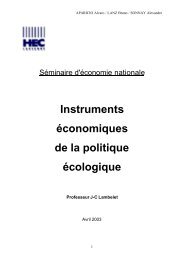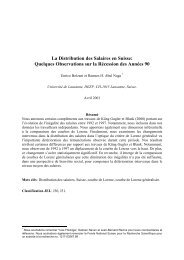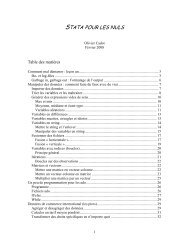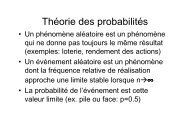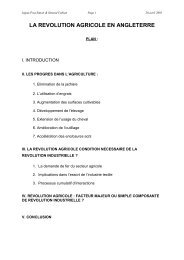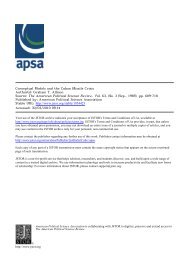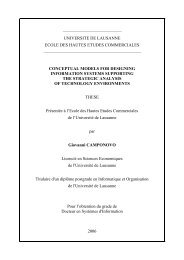Do consumer s tastes differ final 1.7. - HEC
Do consumer s tastes differ final 1.7. - HEC
Do consumer s tastes differ final 1.7. - HEC
Create successful ePaper yourself
Turn your PDF publications into a flip-book with our unique Google optimized e-Paper software.
D O C ONSUMER’ S T ASTES D IFFER?<br />
estimation by weighted least squares results in insignificant F-values depicting that income flexibility is<br />
independent of real income.<br />
Consequently, income coefficients and income flexibility seem to be unrelated to income and prices.<br />
Additionally, the constancy of these coefficients suggests that they are fundamental parameters<br />
characterizing <strong>tastes</strong>, which are invariant in a wide variety of economic circumstances.<br />
Another indication of <strong>consumer</strong>s’ similarities on an international level is the fact that ninety-five<br />
percent of the parameter estimates of model 1 lie within the two-standard-error bands of the<br />
estimates of models 2 and 3.<br />
The criterion of information inaccuracy provides good results for model 3, pointing in favour of<br />
<strong>consumer</strong>s being not too dissimilar. Nevertheless, it needs to be clarified that the data relates to broad<br />
aggregates comprising ten commodity groups so that there might be more disparities in taste for<br />
smaller aggregates. Another aspect, which needs to be considered, is the inclusion of unexplained<br />
factors like the constant terms. The assumption of similar <strong>tastes</strong> has been taken under exclusion of the<br />
influence of these terms, which could in fact be culture, tradition, habits or even specific preferences.<br />
Therefore, unexplained factors need to be used with precaution in order not to influence the reliability<br />
of the model’s results.<br />
Clements/Chen: Fundamental Similarities in Consumer Behaviour7<br />
The authors want to attack the question why for example Asians eat rice and Europeans eat bread,<br />
whether this is due to a <strong>differ</strong>ent price level, to <strong>differ</strong>ent <strong>tastes</strong> or to tradition.<br />
The main <strong>differ</strong>ence to the models used by Selvanathan is that Clements and Chen compare two<br />
groups of countries: 18 OECD countries with 13 least developed countries (LDC). The commodities<br />
used are food, clothing, housing, durables, medicine, transport, recreation, and “other”, using the<br />
same categories except beverages and education compared to Selvanathan.<br />
Forces, which could blur the <strong>differ</strong>ences, are that barriers to international trade have fallen, e.g.<br />
transport and communication costs, leading to an explosion of world trade, international travel and<br />
migration, supporting the tendency towards homogeneity of consumption patterns in <strong>differ</strong>ent<br />
countries.<br />
The consumption patterns in the group of OECD countries are compared with those in developing<br />
countries. OECD countries spend relatively less on food (29,59% < 40,44%); these “savings” are<br />
redistributed to housing and transport. An analysis of the Divisia price and quantity variance, which<br />
measure cross commodity dispersion, shows that first, the coefficients of variation are fairly similar in<br />
the OECD and LDC countries and second, the price-quantity correlation is almost exactly the same.<br />
These findings point to important international similarities<br />
Constancy of <strong>tastes</strong><br />
Utility maximisation theory usually postulates that <strong>tastes</strong> are fixed, so that the only observable<br />
variables, income and prices, explain consumption. The hypothesis of stable preferences is tested by<br />
comparing estimates of demand equations for the OECD with those for the LDCs.<br />
Autonomous trends are observed to be fairly close in the two groups of countries, except for<br />
transport. The income elasticity for food is lower in the OECD and for transport a significant <strong>differ</strong>ence<br />
has been found. The remaining six commodities show fairly similar elasticities. Regarding price<br />
elasticity, only the <strong>differ</strong>ences for clothing and transport are highly significant. The data regarding<br />
transport points to the possibility of fundamental <strong>differ</strong>ences between the OECD and LDC countries,<br />
otherwise a surprising degree of similarity in <strong>consumer</strong> behaviour across widely <strong>differ</strong>ing groups of<br />
countries can be suspected.<br />
If observable <strong>differ</strong>ences in income and prices are controlled for, then consumption patterns are more<br />
or less the same worldwide; at least at a first approximation <strong>differ</strong>ences in taste appear to play no role.<br />
This finding is subject to two qualifications: first, the commodities analysed are broad aggregates and<br />
7 This paragraph summarizes Clement, K.W. and D. Chen, Fundamental similarities in <strong>consumer</strong> behaviour, Applied economics, 1996, 28,<br />
747-757<br />
B EKE T INNEBERG 8<br />
19 MARCH 2003




